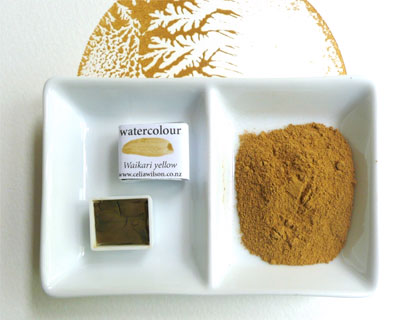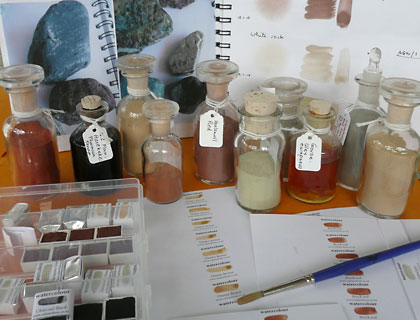From her home in Oxford, fine artist Celia Wilson is capturing the colours of Canterbury in way that could not be more down to earth. She creates paint using pigments she gathers from the local landscape, both as a craft process in its own right and also as a part of her own art practice.
What do you make?
I make watercolour, oil and acrylic paint from pigments that I find around me. These pigments range from clay and plants in the garden, to small rocks in a river, pebbles on the beach, coloured earths gleaned from roadside cuttings or quarries, and discarded objects such as bricks or glass.
How did you get into your craft?
Curiosity about how artists’ paint, a material we take for granted, is made; the knowledge that so many of our present paint pigments come from by-products of the petroleum industry and the fact that we import most (if not all?) of our artists’ paint.

Do you have formal training or qualifications in your craft?
Not in paint making specifically; I have a Bachelor of Fine Arts degree and my 2008 postgraduate year research was about locally found pigments in Canterbury and their historical, experimental and contemporary use in paint. I have always had a general interest in geology and landforms in the landscape.
I learnt how to make paint during the experimental process of that year’s research, using formulas found in old painting technology books. I investigated paint making as done by Europeans and New Zealand Maori before paint manufacture became an industrialised process. The skill and knowledge held by both peoples has to a large extent been forgotten, and colour often formed part of social customs as well as having utilitarian and decorative use.
Above: Celia’s process from pigment to paint.
Your favourite materials, tools and processes?
Grinding the pigment into the medium (binder) with a muller; the fascination with how the colour of the paint appears during this process. The colour can be quite different to the raw pigment, and the different binders – gum arabic, linseed oil, acrylic base – all produce a different end colour from the same pigment as well.
Five words that describe your mind:
Chaotic, dreamy, curious, acquisitive, conscientious.
Describe your workspace:
An old potting shed/greenhouse. Lovely and warm in the winter, though I fight for space in the spring when the seedlings are growing!
What inspires you? Colour.
Above: Hidden secrets of ‘them thar hills…’ – “There is a wealth of colour hidden beneath our feet. It is not easy to find these colours, but occasionally opportunities arise. I use these colours to make my paints.”
Is there a philosophy behind your work?
Having a background in running a certified organic orchard, I look for simple, efficient, non-toxic ways of doing things. I feel uneasy about the ‘extractive’ implications of using a resource which in my case is rock, and would like to find more recyclable materials, like bricks. I do use charcoal from the log burner, and plants can provide colour of course.
However, I know that about 15mls of pigment makes about 5–7 half-pans of watercolour paint which are each about quarter of a teaspoon (1.25mls) in volume, and each half-pan lasts for a long time. All the ingredients for paint binders are available or produced in New Zealand, such as gum from cherry trees (Prunus varieties), linseed oil from the flax plant (Linum usitatissimum), and bees wax.
While I appreciate commercial paint, it is however (thankfully) uniform, but handmade paint from unrefined pigments can produce varying results which I find valuable in a different way. Each batch of paint can vary, but the colour obtained will be hand painted onto the label together with the location as described in the name of the paint. My interest is not in colour batch uniformity and adherence to a standardised colour identification system, but in colour that is found at a certain location which just happens to be green, red or brown etc.
What was the last handmade item you bought?
Now I feel guilty, as apart from receiving handmade presents, the last handmade item I bought was some of Canterbury artist Mark Lander’s rag paper for prints.
Your hero/heroine:
Aldo Leopold, the scientist, forester and environmentalist, who wrote A Sand Country Almanac in 1948.
Do you have any pets?
A cat called Casper, and presently also looking after Orange and Aubrey, both cats, and refugees from Christchurch. They are keeping me in order…
Your favourite feedback from a customer:
Just love the paints in their wrappers as objects!
You can see more of Celia’s paints on Felt or visit her website to see the paintings she creates with them. Celia’s work features in a group exhibition, Colour of Distance, at the Papakura Art Gallery in Auckland from 3 March until 4 April 2012, and again in a group show entitled Sense of Place in the Hastings City Art Gallery from 28 July until 9 September.










amazing work. i love the paints!
I’ve been admiring Celia’s work for a while now (after stumbling across her handmade paints on felt), and am so happy to see her featured on your blog. What an inspiring lady – Celia is truly taking the ‘handmade’ concept right back to the earth.
Where the tools and products we use to make our handmade items come from is something we should all try to be aware of.